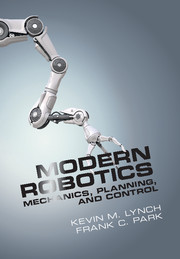Book contents
- Frontmatter
- Contents
- Foreword by Roger Brockett
- Foreword by Matthew Mason
- Preface
- 1 Preview
- 2 Configuration Space
- 3 Rigid-Body Motions
- 4 Forward Kinematics
- 5 Velocity Kinematics and Statics
- 6 Inverse Kinematics
- 7 Kinematics of Closed Chains
- 8 Dynamics of Open Chains
- 9 Trajectory Generation
- 10 Motion Planning
- 11 Robot Control
- 12 Grasping and Manipulation
- 13 Wheeled Mobile Robots
- A Summary of Useful Formulas
- B Other Representations of Rotations
- C Denavit–Hartenberg Parameters
- D Optimization and Lagrange Multipliers
- Bibliography
- Index
1 - Preview
Published online by Cambridge University Press: 04 June 2024
- Frontmatter
- Contents
- Foreword by Roger Brockett
- Foreword by Matthew Mason
- Preface
- 1 Preview
- 2 Configuration Space
- 3 Rigid-Body Motions
- 4 Forward Kinematics
- 5 Velocity Kinematics and Statics
- 6 Inverse Kinematics
- 7 Kinematics of Closed Chains
- 8 Dynamics of Open Chains
- 9 Trajectory Generation
- 10 Motion Planning
- 11 Robot Control
- 12 Grasping and Manipulation
- 13 Wheeled Mobile Robots
- A Summary of Useful Formulas
- B Other Representations of Rotations
- C Denavit–Hartenberg Parameters
- D Optimization and Lagrange Multipliers
- Bibliography
- Index
Summary
As an academic discipline, robotics is a relatively young field with highly ambitious goals, the ultimate one being the creation of machines that can behave and think like humans. This attempt to create intelligent machines naturally leads us first to examine ourselves – to ask, for example, why our bodies are designed the way they are, how our limbs are coordinated, and how we learn and perform complex tasks. The sense that the fundamental questions in robotics are ultimately questions about ourselves is part of what makes robotics such a fascinating and engaging endeavor.
Our focus in this book is on mechanics, planning, and control for robot mechanisms. Robot arms are one familiar example. So are wheeled vehicles, as are robot arms mounted on wheeled vehicles. Basically, a mechanism is constructed by connecting rigid bodies, called links, together by means of joints, so that relative motion between adjacent links becomes possible. Actuation of the joints, typically by electric motors, then causes the robot to move and exert forces in desired ways.
The links of a robot mechanism can be arranged in serial fashion, like the familiar open-chain arm shown in Figure 1.1(a). Robot mechanisms can also have links that form closed loops, such as the Stewart–Gough platform shown in Figure 1.1(b). In the case of an open chain, all the joints are actuated, while in the case of mechanisms with closed loops, only a subset of the joints may be actuated.
Let us examine more closely the current technology behind robot mechanisms. The links are moved by actuators, which typically are electrically driven (e.g., by DC or AC motors, stepper motors, or shape memory alloys) but can also be driven by pneumatic or hydraulic cylinders. In the case of rotating electric motors, these would ideally be lightweight, operate at relatively low rotational speeds (e.g., in the range of hundreds of RPM), and be able to generate large forces and torques. Since most currently available motors operate at low torques and at up to thousands of RPM, speed reduction and torque amplification are required. Examples of such transmissions or transformers include gears, cable drives, belts and pulleys, and chains and sprockets.
- Type
- Chapter
- Information
- Modern RoboticsMechanics, Planning, and Control, pp. 1 - 9Publisher: Cambridge University PressPrint publication year: 2017



